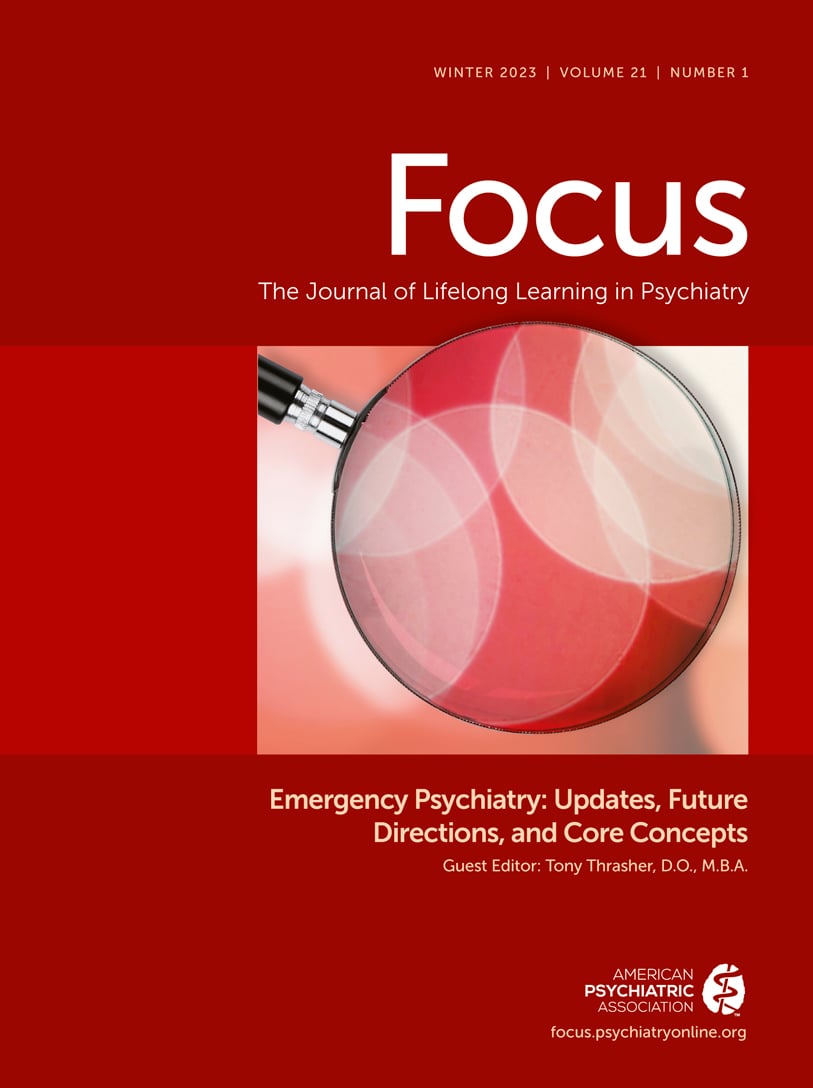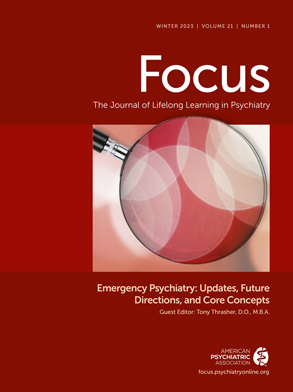Is the emergency department the appropriate place for patients with substance use disorders to access treatment?
Emergency departments (EDs) across the United States are increasingly called on to care for patients with substance use disorders (
1). As the nation faced a pandemic in 2020, general ED visits decreased, but visits for mental health conditions and substance use disorders showed a relative increase (
2). Despite presenting to EDs in such high numbers, according to the National Survey on Drug Use and Health, in 2019, only 1.5% (4.2 million people) received any treatment for substance use disorders in the previous year, and only 514,000 identified the emergency room as the location where they received treatment (
3). EDs across the country have responded by creating amazing ways to engage patients with substance use disorders, initiate treatment, and refer them to additional treatment (
4,
5).
Patients who present to EDs seeking treatment for their substance use disorder face an uphill battle. They are presenting with conditions that are not viewed by many health care providers as an “emergency,” and face health care workers who may have a negative attitude toward substance use (
6). Several studies have shown that staff feel unprepared and struggle to show empathy to patients with substance use disorders (
7,
8). A 2008 paper based on thousands of observed interactions in a California ED identified several prominent themes, such as the following: Providers were concerned about drug-seeking behavior, and they had to balance the needs of substance-involved patients with the necessity to manage limited resources. There have been many attempts to combat these challenges and engage staff in the care of patients with substance use disorders who are in treatment in EDs. Educational experiences, and even communicating positive stories about recovery to staff, have been found to be effective in reducing the stigma of substance use disorders (
9). Peer supports or recovery coaches have been used in a variety of settings and have shown great potential in substance treatment centers (
10). The use of peer supports in EDs is a newer implementation, and a recent large randomized controlled trial found them to be as effective as clinical social workers in engaging substance use disorder treatment (
11).
Patients using substances present to EDs for various reasons, but unless they identify their substance use as a problem, it may go unrecognized. There are several validated tools for screening substance use disorders, but adapting them for use in an ED that may not offer a private area for discussion can make their use challenging. The greatest advances in screening tools for use in the ED involve screening for alcohol use disorder. The CAGE (Cut down, Annoyed, Guilty, Eye-opener) questionnaire has been in use since the 1980s (
12), and the Alcohol Use Disorders Identification Test-Concise (
13) is a tool frequently used to assess alcohol use. For other substance use disorders, the single screening test question “How many times in the past year have you used an illegal drug or used a prescription drug for a nonmedical reason?” was found to be 100% sensitive and 73.5% specific in a Boston primary care setting, and it may be adaptable to the ED setting (
14).
EDs are in a unique position to possibly start treatment for substance use disorders and connect patients directly to ongoing treatment. Interventions in the ED can range from brief motivational interviewing to the administration of medication. Brief interventions have been shown to be effective in reducing alcohol consumption and harmful events in primary care, inpatient, and ED settings (
15). The length of time of the intervention varies tremendously throughout the studies of brief interventions, but it is notable that even 5 minutes of simple advice and counseling was shown to be effective (
16). The SBIRT (screening, brief intervention, and referral to treatment) model has been studied in EDs and has shown significant reductions in at-risk drinking up to 3 months postintervention (
17). The most exciting evidence for treatment options is ED-initiated treatment for opioid use disorder. In a 2015 study, the authors found that 78% of the patients initiated on buprenorphine remained in treatment at 30 days, as did 45% of patients receiving a brief intervention and 37% that received a referral (
18). Following this publication, many EDs have begun to use protocols to initiate treatment for opioid use disorders in EDs, and the practice was further solidified by the “Consensus Recommendations on the Treatment of Opioid Use Disorder in the Emergency Department,” a document approved by the board of directors of the American College of Emergency Physicians (
19). The referral to more definitive substance treatment from the ED is something that will vary from system to system and from state to state on the basis of resources and availability but could include 12-step programs, withdrawal management treatment, residential treatment, or intensive outpatient treatment. Recovery coaches, peers, health promotion advocates, and patient navigators have all been helpful in improving connections to substance treatment facilities after discharge from the ED (
20–
22).
As the recipients of millions of patients, EDs are uniquely positioned to identify and guide patients with substance use disorders to treatment, and we owe it to them to have evidence-based options and provide them the best care. There are many great options, but more research is needed to give us more tools; in doing so, however, we have a tremendous opportunity to improve the lives of patients with substance use disorder.

